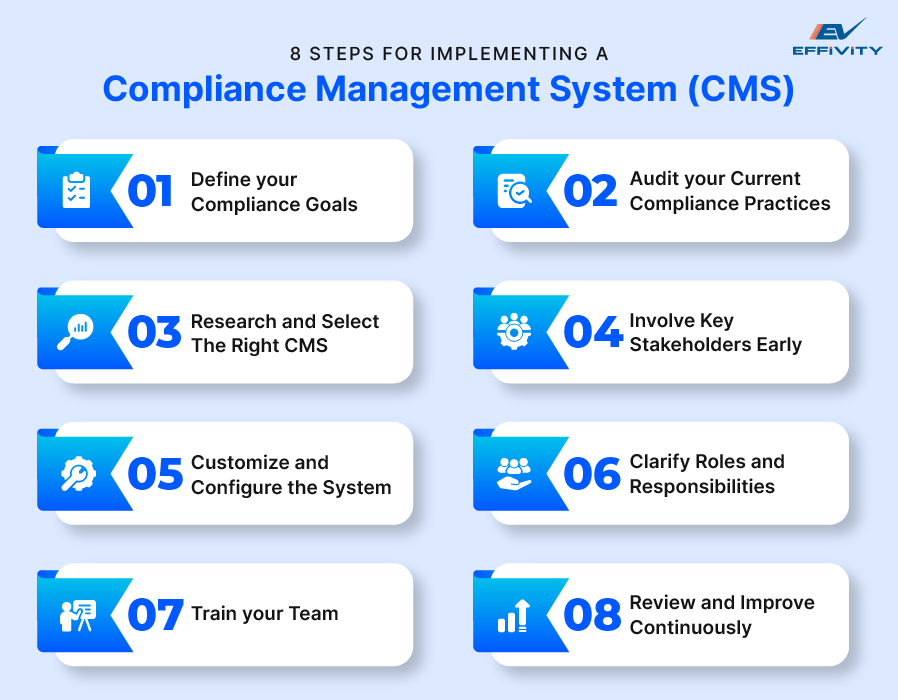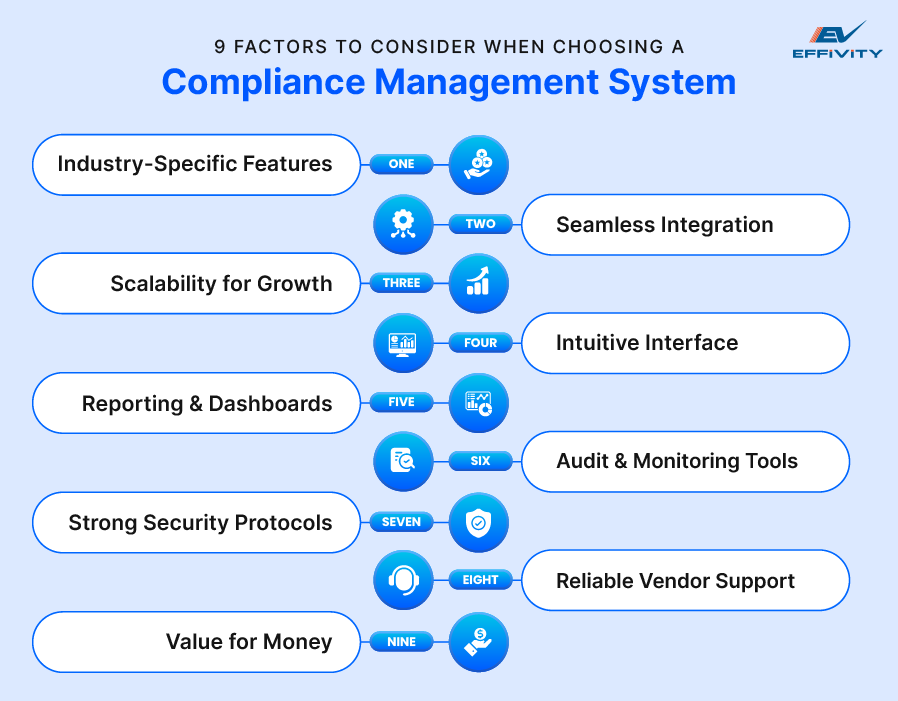Compliance isn’t just about following rules, but it’s about protecting your business. Failing to keep up with regulations relevant to your business can not only cost you your reputation but also negatively impact customer trust.
A Compliance Management System (CMS) offers a smarter, more efficient way to navigate complex regulations as compared to doing all of this manually.
Let’s break down what a CMS is and how it works.
Table of Contents
- What Is a Compliance Management System?
- Why Do You Need a Compliance Management System?
- 3 Core Elements of a Compliance Management System
- How to Implement a Compliance Management System?
- Choosing the Right Compliance Management System for Your Business
- Best Practices to Get the Most Out of Your Compliance Management System
- How Can Effivity Help?
- Frequently Asked Questions
What Is a Compliance Management System?
A compliance management system is a framework that helps businesses meet legal, regulatory, and internal standards. You can think of it as your business’s internal control center for compliance.
At its core, a CMS is designed to simplify complex compliance requirements, reduce risks, and create a culture of accountability within your organization.
It brings together processes, tools, and people to ensure that compliance isn’t just a one-time effort but a continuous part of daily operations.
Why Do You Need a Compliance Management System?
Let’s take a look at the top 5 ways a compliance management system can assist your business:
1. It Keeps You Updated on the Latest Standards, Regulations, and Laws.
Regulations are constantly evolving, and keeping up with these changes can feel like a full-time job.
A CMS tracks these changes for you, ensuring you’re always aligned with the latest requirements. It delivers the information you need, thus saving you time and reducing compliance risks.
2. It Automates Numerous Repetitive and Time-consuming Compliance Tasks
A CMS automates tedious tasks such as tracking employee certifications and filing mandatory reports, which are prone to human error if done manually.
By letting the system handle the grunt work, your team can focus on strategic priorities rather than getting bogged down in paperwork.
3. You Can Spot Issues Beforehand
Non-compliance can snowball quickly if it’s not caught early.
With a CMS, you can identify potential issues before they spiral out of control, such as missing documentation or the smallest of policy violations. This is possible because of the built-in alerts and monitoring tools within a CMS that give you real-time insights (and even predict problems).
4. A CMS Helps You Organize All Your Compliance Documents
Compliance often requires you to maintain a mountain of records, from audit trails to permits to training certifications.
A CMS serves as a centralized hub where all your compliance documents are stored securely and are easy to retrieve.
5. Audits Are a Breeze with CMS
A compliance management system allows you to create automated audit trails that show exactly what’s been done, who did it, and when. This makes the whole process transparent, precise, and efficient.
3 Core Elements of a Compliance Management System
A compliance management system mainly has three main elements as follows:
1. Board of Directors
The board of directors is responsible for overseeing compliance efforts and ensuring the organization operates ethically and legally.
This includes approving compliance policies, reviewing reports, and holding leadership accountable. The board of directors can also appoint a compliance officer to supervise the compliance program and report progress.
Without a strong board commitment, it’s impossible to embed compliance into your company culture.
2. Compliance Program
The compliance program is the backbone of your CMS. It includes:
- Policies and Procedures: These are clearly defined compliance rules or guidelines tailored to your business. They cover everything from data protection to workplace safety.
- Training and Education: A good compliance program includes regular training sessions and resources to keep all employees informed on the compliance terms.
- Compliance Monitoring: Ongoing checks ensure policies are being followed as well as help identify areas for improvement.
3. Compliance Audit
A compliance audit is a thorough review of your compliance management system. This involves:
- Internal Audits: Conducted by the organization itself to identify gaps in its compliance framework
- External Audits: Performed by third parties; they provide an unbiased assessment of your CMS
How to Implement a Compliance Management System?
Setting up a compliance management system might sound daunting, but it’s pretty simple once you break it down into clear, actionable steps.
So, here’s a quick step-by-step guide to get your CMS up and running efficiently:

1. Know What You Want in a CMS
Start by identifying your business’ specific compliance needs.
For example, which regulations or standards do you want in your CMS? Are you looking to meet industry standards or just improve your audit readiness?
This clarity will help you choose features that align with your goals.
2. Assess Where You Stand Currently in Terms of Compliance
Review your current compliance practices to understand gaps, outdated procedures, and team struggles. Identifying such shortcomings helps you prioritize when setting up your CMS.
3. Compare Different CMS Options in the Market
Don’t just go for the most popular tool—find one that fits your business size, industry, and growth plans.(We’ve explained how you can choose the right CMS software for your business in the next section.)
4. Engage Your Stakeholders
Compliance isn’t just a back-office function—it impacts everyone in your organization.
So make sure you involve key stakeholders early from department heads to IT teams. Their insights are valuable for a smooth rollout.
5. Configure Your Compliance Management System
Once you’ve chosen your CMS, configure it to match your company’s needs. This step involves customizing workflows, uploading relevant policies, and setting up alerts for critical compliance tasks.
6. Make Sure Everyone Knows Who Handles What in Compliance
Establishing clear roles and responsibilities is vital for a CMS to succeed. Assign specific team members to oversee key areas like audits, reporting, or document updates.
When everyone knows their role, compliance becomes a team effort.
7. Train Your Team
Your CMS can be a great tool, but its success really depends on how well your team uses it. Therefore, conduct regular training sessions so that your employees can navigate the system easily and tackle any issues that come up.
8. Review and Update Your CMS Regularly
Finally, set a schedule to regularly review your system. By doing so, you’ll ensure your CMS stays in line with any new regulations. In fact, internal audits help you update policies and take in feedback from users.
Choosing the Right Compliance Management System for Your Business
Let’s explore 9 crucial factors to consider when choosing CMS that truly works for your business:

1. Think About Industry-specific Features
Every industry has its own compliance needs. For instance, healthcare may require HIPAA compliance, while financial services may require robust reporting features and ISO 27001 support.
So, choose a compliance management software designed for your industry’s unique needs.
2. Ensure Compatibility with Your Existing Systems
Your CMS should work seamlessly with the tools you already use, such as accounting software, HR systems, communication platforms, etc.
3. Consider Future Growth and Scalability
Think long-term. Can the CMS handle your business as it expands?
Look for solutions that can scale with you, whether you’re hiring more staff, expanding globally, or facing new regulatory demands.
4. Prioritize User-friendly Interfaces
A complicated system can be frustrating. Select a CMS with a clean, intuitive interface so that your team can use it effectively without needing constant assistance.
5. Look for Great Reporting and Dashboard Features
Choose compliance management software that offers dashboards for a clear view of your compliance status. It should also allow you to create detailed reports whenever needed.
6. Choose Strong Audit and Monitoring Tools
Since audits are a key part of compliance, make sure your CMS includes features like automated audit trails, real-time monitoring, and incident tracking. These tools will help you manage audits more easily and stay ahead of compliance challenges.
7. Check for Security and Privacy Protections
Your compliance management software will handle sensitive data, so security is non-negotiable. Look for features like data encryption, role-based access controls, and compliance with privacy standards such as GDPR or CCPA.
8. Find Out About Vendor Support and Updates
Choose vendors that offer ongoing support and regular software updates. You can check customer testimonials and ask about their support options before making a decision.
9. Weigh Costs Against the Value Provided
Don’t invest in CMS just for the sake of doing it. By choosing the right CMS, you can save time and reduce compliance risks. So, look beyond just the price and consider the value you’ll receive from the features offered.
Best Practices to Get the Most Out of Your Compliance Management System
Having a compliance management system is a great start, but to truly see its benefits, you need to use it effectively.
Here are some best practices to help you maximize your CMS’s potential:
1. Keep Policies Simple and Accessible
Complicated policies confuse employees and create room for errors.
Use straightforward language, and make your policies easy to find by adding them to your CMS. This way your employees can quickly refer to the rules when needed.
2. Make Compliance a Team Effort
Involve every department and make sure everyone understands their role in staying compliant. When the whole team contributes, compliance becomes an integral part of your workplace culture.
3. Invest in the Right Technology
The right tech can streamline tasks, enhance compliance monitoring, and make audits easier. So, regularly assess whether your CMS as well as other tools are meeting your needs and upgrade when necessary.
4. Encourage Open Communication
Create an environment where employees feel comfortable reporting issues, seeking clarification, or sharing their suggestions. Open communication helps catch problems early and reinforces the importance of compliance across the organization.
5. Focus On Continuous Training
Compliance regulations change frequently, and so do business needs. Schedule regular training sessions to keep your team up-to-date and confident in using the CMS.
This ongoing education is crucial for avoiding compliance fatigue and maintaining employee engagement.
How Can Effivity Help?
We understand that handling ISO standards, industry regulations, or internal policies can be challenging. That’s where Effivity’s CMS steps in.
You can easily set up and customize your compliance process without needing any technical skills. In fact, our compliance management system adapts to your industry, size, and requirements, fitting right into your workflow.
We offer everything from risk assessments and document management to audits and reporting, helping you stay compliant with confidence.
Frequently Asked Questions (FAQs)
1. What industries benefit most from a compliance management system?
Industries that deal with sensitive data, safety protocols, or complex compliance requirements benefit the most from a CMS. This includes healthcare, manufacturing, financial services, construction, and IT.
2. How long does it take to implement a CMS?
The time varies depending on the system and your business’s complexity. On average, it can take anywhere from a few weeks to a few months for full implementation, including setup, configuration, and team training.
3. Can a CMS help with multiple regulatory frameworks at once?
Yes, most compliance management software are designed to handle overlapping regulations. For example, a CMS can simultaneously support GDPR, HIPAA, ISO standards, and other regional or industry-specific requirements.
4. What happens if I don’t use a CMS for compliance?
Without a CMS, you risk non-compliance penalties, human errors, inefficiency, operational bottlenecks, incomplete documentation, as well as jeopardizing your business’s reputation.
5. Is there a difference between a CMS for small businesses and large enterprises?
Yes, CMS tools for small businesses are usually simpler, focusing on ease of use and affordability. Enterprise-level CMS platforms offer advanced features like scalability, multi-location support, and comprehensive integration capabilities.





























